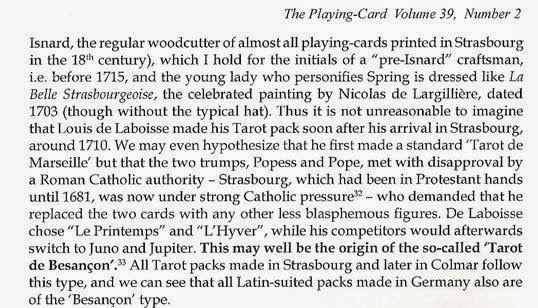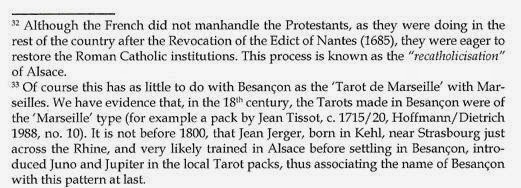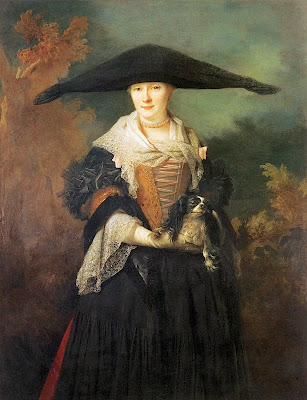Thanks for the link to Depaulis. I'll read it. The export of Minchiate to Germany is interesting, as you say, since from the German side one wouldn't have guessed it.
Isnard is relevant mainly for French-suited decks, although I suppose he could have made Italian-suited ones, too.
I have been looking at what Dummett says in
Il Mondo e l'Angelo about Italian-suited tarot in Switzerland, Germany, and points east. It might be useful at this point for me to skip over Dummett's account of Milan, France, and Belgium temporarily. His chapter 15, on Italian-suited tarot outside of Italy (I TAROCCHI CON SEMI ITALIANI ALL’ESTERO) contains much material that I do not remember seeing in
Game of Tarot.
First, Switzerland (p. 379f):
La nostra documentazione per le carte da tarocchi svizzere è ancora più scarsa che per le carte francesi: non posse-[end of 379] diamo un solo esempio risalente a prima del XVIII secolo. Più frequenti sono i riferimenti su documenti. Nel tedesco della Svizzera, il gioco è noto come ‘Trogga', Trogge', 'Troggen' o ‘Truggen'; in romancio, come ‘Troccas'. Il riferimento più antico è del 1572, un’ordinanza in cui troggen è citato, con altri due giochi di carte, come autorizzato6. Altri riferimenti del genere risalgono al 1588, 1593 e 1599. Continuano nel XVII secolo, nel 1620, 1627, 1650 e 1662, e fino al XVIII nel 1701, 1712, 1732 e 1741 7. Durante il XVIII secolo, il gioco diventò molto popolare nel bel mondo svizzero, e fra gli eruditi, incluso il celebre matematico Johann Bernoulli II 8. È interessante notare che in Svizzera il gioco dei Tarocchi era talvolta chiamato, senza alcun motivo, «Martin-Lüter-Spiel» («gioco di Martin Lutero») 9.
(Our documentation for Swiss tarot cards is even more scarce than for the French cards: we have [end of 379] only one example dating from before the eighteenth century. More frequent are the references in documents. In German Switzerland, the game is known as '‘Trogga', Trogge', 'Troggen' o ‘Truggen'; Romansh as 'Troccas’. The earliest reference is 1572, an order in which troggen is mentioned, along with two other card games, as authorized 6. Other references of this kind date back to 1588, 1593 and 1599. Continuing in the seventeenth century, in 1620, 1627, 1650 and 1662, and in the eighteenth, 1701, 1712, 1732, 17417. During the XVIIIth century, the game became very popular in the Swiss bel monde, and among scholars, including the famous mathematician Johann Bernoullis. It is interesting to note that in Switzerland the game of Tarot was sometimes called, for no reason, " Martin-Luther-Spiel" ("Game of Martin Luther") 9.
____________________________
6. Schwieizerdeutches Wörterbuch, Vol XIV, Frauenfeld, 1978 sv 'Trogge' and 'trogge(n)' coll. 676-9. I owe this source to Dr.. Peter Kopp.
7. For all these references, see the Schweizerdeutches Wörterbuch, ibid., and Grimm, Deutsches Wörterbuch, Vol XI, p. 1, quoting from Hoffmann-Krayer, Schweizerische Archiv für Folkskunde, Vol V, p. 281.
8. Balz Eberhard, 'Spielkarte und Spielkartensteuer in der Republik Helvetischen, 1798-180', Zeitschrift für Schweizerische Archäologie und Kunstgeschichte, Vol 30, 1973. 169-84, and 'Die Entwicklung der Tarocke in der Schweiz', Schweizer Spielkarten (catalog), Zurich, 1978, pp. 180-1. Eberhard mistakenly believes that the game of Tarot had not arrived in Switzerland before the XVIIIth century.
9. Schweizerdeutsches Wörterbuch, Vol. XIV, col. 676.
These footnotes are very helpful, especially the one for 1572. I am not sure that the game would be called "Martin Luther Spiel" for no reason. And by whom, Catholics or Protestants?
Then there is the question of how it came to Switzerland. Dummett argues for at least part of the country, that it was from Italy (p. 380f) :
Dai riferimenti cinquecenteschi pare probabile che il gioco dei Tarocchi sia giunto in Svizzera più o meno nella stessa epoca in cui si diffuse in Francia, e cioè all’inizio del XVI secolo, quando gli Svizzeri erano molto coinvolti nelle guerre in Lombardia, fino alla loro sconfitta a Marignano nel 1515. Ciò è reso ancora più probabile dal fatto che nella forma del gioco ancora praticata nel Cantone dei Grigioni sono rispettate due tipiche usanze italiane. Secondo la prima, dopo qualsiasi giro della distribuzione delle carte, qualsiasi giocatore può proporre che essa sia annullata; se tutti sono d’accordo, si rimettono insieme le carte e si dà il via a una nuova distribuzione. Per la seconda il giocatore che ha in mano il trionfo più alto può battere sul tavolo con le nocche per informare il compagno. La prima di queste usanze è ben nota con l’espressione «andare a monte» in molti giochi di carte italiani; la seconda, con variazioni, si trova nelle forme di Tarocchi bolognesi e si-[end of 280]ciliane e in altri giochi. Il gioco praticato nei Grigioni mostra scarsi segni di evoluzione ed è molto simile a quello descritto come tipico della Svizzera nella Maison académique del 1659; evidentemente, i giocatori di questa regione svizzera, come quelli di altre, sono molto conservatori. Il fatto che abbiano conservato queste due caratteristiche minori, ma tipicamente italiane, del gioco suggerisce una sua derivazione diretta dall’Italia piuttosto che dalla Francia. In una conferenza sul gioco di Troccas nei Grigioni, Mile. Carla Deplazes ha comunicato che il primo riferimento si trova in un libro di devozione del 1668, pubblicato a Scuol nell’Engadina, che afferma che a Dio non aggrada che si giochi al Tarocco la domenica, ma a suo parere il riferimento non significa molto essendo una traduzione dall’inglese. Tuttavia, è molto improbabile che l’originale inglese si riferisse al gioco del Tarocco; la menzione di questo gioco deve essere una sostituzione fatta dal traduttore, e perciò serve a riprova della pratica del gioco nei Grigioni a quel tempo. Per la ragione sopraddetta, nel 1668 il gioco era conosciuto in Svizzera probabilmente da centocinquant’anni.
(From the sixteenth-century references, it seems likely that the game of Tarot in Switzerland has come more or less in the same period in which it spread to France, and that is the beginning of the sixteenth century, when the Swiss were very involved in the wars in Lombardy, until their defeat at Marignano in 1515. This is made more likely by the fact that in the form of the game still practiced in the canton of Grisons are met two typical Italian customs. According to the first, after any round of cards are dealt, any player may propose that it be set aside; if everyone agrees, they recombine the cards and give way to a new distribution. The second player who holds the highest triumph can beat on the table with his knuckles to tell his partner. The first of these customs is well known by the expression "andare a monte" in many Italian card games; the second, with variations, is found in forms of Bolognese and Si-[end of 380]cilian Tarot and other games. The game played in Grisons shows little sign of evolution and is very similar to the one described as typical of Switzerland in the Maison académique 1659; obviously, the players of this region of Switzerland, like those of others, are very conservative. The fact that they kept these two minor features, typically Italian,in the game suggests its direct derivation from Italy rather than France. In a lecture on the game Troccas in Grisons, Mile. Carla Deplazes communicated that the first reference is in a book of devotion, in 1668, published at Scuol in Engadine, which states that God does not like Tarot games on Sundays, but in her opinion the reference does not mean much since it is a translation from English. However, it is very unlikely that the original English version was referring to the game of Tarot; the mention of this game should be a substitution done by the translator, and therefore serves as proof of the practice of the game in Grisons at that time. For the aforesaid reason, in 1668 the game was known in Switzerland probably for a hundred and fifty years.
150 years! That is quite a claim. Huck's proposal of the Swiss Guards is another idea. "Andare a monte" is an idiom normally meaning "come to nothing", but in card games something else, I haven't bothered to find out what; see
http://www.dizionario.org/d/?pageurl=andare-a-monte.
Against the view that Tarot in Switzerland comes from Italy, there is the argument that since the decks used in the German speaking parts of Italy are written in French, the game spread there from the French-speaking cantons. But Dummett says:
L’uso, in regioni di lingua tedesca e romancia della Svizzera, di carte con scritte in francese suggerisce che il gioco si diffuse dapprima nei Cantoni di lingua francese. Questo argomento, però, non è conclusivo. Sappiamo dall’ordinanza del 1572 che il gioco era già praticato in Svizzera da parlanti in tedesco; ma la pratica di scrivere sulle carte i nomi dei trionfi ebbe origine probabilmente ottantanni più tardi. La conservazione delle scritte francesi significa solo che questa pratica fu introdotta, direttamente o indirettamente, dalla Francia, o almeno da aree di lingua francese.
(The use, in German and Romansh-speaking regions of Switzerland, of cards written in French suggests that the game spread first into the French-speaking cantons. This argument, however, is not conclusive. We know from the order of 1572 that the game was already practiced in Switzerland by German speakers; but the practice of writing the names on the cards of the triumphs originated probably eighty years later. The preservation of written French only means that this practice was introduced, directly or indirectly, from France, or at least areas of the French language.)
He is not sure where this practice of writing the titles came from, Switzerland or France, but of the three Parisian decks of the 17th century, titles are not on the Vieville but are on the Anonymous Parisian and Noblet. All are 1750-1770, he says. Hence the "eighty years".
Dummett then turns to Germany:'
Ci sono prove contrastanti a proposito dell’arrivo del gioco in Germania. Verso la metà del XVIII secolo, troviamo giocatori tedeschi che usano una terminologia francese e giocatori viennesi che praticano un gioco di origine lombarda e usano termini italiani.
(There is conflicting evidence about the arrival of the game in Germany. Towards the middle of the XVIIIth century, we find German players who use French terminology and Viennese players who practice a game of Lombard origin and use Italian terms.
The Germans--here Dummett includes Alsace--clearly did not have the tarot in 1590, when the German translator (publishing in Strassburg) greatly expanded Gargantua's list of games but did not include tarot. Yet the
Maison Academique in 1659 says that the Germans played nothing else! Dummett proposes:
Ivan Honl asserisce, in un libro del 1947, che le carte da tarocchi sono nominate per la prima volta in Boemia nel 1596 11. È pertanto possibile che il gioco entrasse originariamente in Germania dalla Svizzera e non dalla Francia, e che divenisse popolare nella parte orientale del paese e in Boemia prima di raggiungere la Germania occidentale.
(Ivan Honl claims, in a book of 1947, that tarot cards are named for the first time in Bohemia in 1596 11. It is therefore possible that the game originally came to Germany from Switzerland and France, and it became popular in the eastern part of the country and in Bohemia before reaching western Germany.
___________________
11. 20. Honl, Z Minulosti Karetní hry v Cechách, Prague, 1947, p. 31. Unfortunately, Honl does not provide complete data.
But what kind of deck would they have used? Dummett says that it could have been the Tarot of Besancon, wending its way west:
I tarocchi con semi italiani pervenutici, prodotti nell’Europa Centrale nel XVIII secolo, esemplificano quasi tutti il Tarocco dì Besançon; le poche eccezioni sono esempi della versione lombarda del Tarocco di Marsiglia. Possiamo solo ipotizzare quale tipo di tarocchi fosse originariamente usato in Germania e Boemia; forse si trattava di una versione del Tarocco di Besançon senza le scritte, che potrebbero essere state aggiunte nel corso del XVII secolo, quando i fabbricanti di carte dell’Alsazia (francese dal 1648) o di altre parti della Francia cominciarono a esportare mazzi di tarocchi in Germania. In tal caso, i mazzi del Tarocco di Besançon con scritte in francese potrebbero essere stati originariamente introdotti in Svizzera dalla Germania. Queste, naturalmente, sono semplici congetture; ci mancano i dati per trarre deduzioni sicure.
(The surviving tarots with Italian suits produced in Central Europe in the eighteenth century almost all exemplify the Tarot of Besançon; the few exceptions are examples of the Lombard version of the Tarot of Marseilles. We can only speculate what type of tarot cards were originally used in Germany and Bohemia; perhaps it was a version of the Tarot of Besançon without the lettering, which may have been added during the seventeenth century, when the card makers of Alsace (French from 1648) or other parts of France began to export tarot decks into Germany. In this case, the decks of the Tarot of Besançon with writing in French may have been originally introduced into Switzerland from Germany. This, of course, is pure conjecture; we lack the data to draw reliable conclusions.)
That concludes Dummett's discussion. The Lombard version in Milan, Dummett says elsewhere in the book, would have come from Milan in the 18th century, when Austria ruled Lombardy. The 1648 date is misleading; Strasbourg did not come under French control until 1681 (
http://en.wikipedia.org/wiki/Alsace#Inc ... nto_France).
From Depaulis we have more data; but at the same time he only presents a coherent picture by discounting Dummett's sources, dismissing the
Maison Academique as totally unconfirmed and not mentioning Honl. Maybe they should be dismissed, I don't know. Tarot in Bohemia might have been brought by the Hapsburgs, since Prague was their capital then; Rudolf II was interested in all sorts of curiosities. Or it had come originally to Innsbruck by way of Bianca Maria Sforza, husband of Maximilian I, and somehow hung on. Or on a more popular level, it might have come up from Italy in the same way as Trappola, from Venice. I can't imagine that it would have been the Besançon in 1599. That would require both the Tarot de Marseille and the Besancon to have been invented in Switzerland or Italy in the 16th century, a formidable proposition. It is barely conceivable to me that both would have come from there in the 17th century. There was no motive for defying tradition and removing the Pope and Popess there. And while Swiss did migrate to Strasbourg in the later 17th century, they were mostly Anabaptists, according to Wikipedia. They would have had no use for the tarot. Surely Depaulis is right that it was invented in Strasbourg around 1710.
But that Depaulis does not find evidence of tarot in Germany before 1659 does not mean it wasn't there. The 30 Years War destroyed a lot of evidence. If Germans played tarot before 1648, it seems to me, there is no telling where it would have come from, Switzerland, France, Italy, or (least probably) the Hapsburg Empire.






